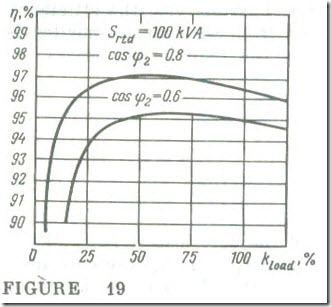Transformer Losses
The ratio of the active power P2 at the output of a transformer to the active power P1 at its input (see Fig. 4) is called its efficiency
ƞ = P2/ P1
or
ƞ% = (P2/P1) X 100 (8.23)
When a transformer is operating at its rated primary voltage, V1 = V1,rtd , its rated primary current, I1 = I1,rtd , and a load power factor ( cos φ2) of over 0.8. the efficiency is very high, being in excess of 99 % for power transformers. For this reason it is never found by directly measuring P1 and P2 . The point is that one would have then to measure P1 and P2 to an extremely high level of accuracy not attainable at the existing state of the art. Fortunately, the efficiency of a transformer can be found indirectly from the transformer losses which can be measured directly. Since the transformer losses are
ΔP = P1 – P2
it follows then that the efficiency is
The transformer losses are the sum of the core losses, Pc , and the winding losses, Pw . Given V1 = V1,rtd and I1 = I1,rtd , the core losses are equal to the active power of the transformer in the open circuit test (see Sec. 8.6), and the winding losses (traditionally called the copper losses) are equal to the active power of the transformer in the short-circuit test (see. Sec. 8.7).
Consider how the efficiency of a transformer varies in operation at the rated primary voltage V1 = V1,rtd into a load whose impedance Z2 is varying and whose power factor cos φ2 remains constant. A change in Z2 brings about a change-In the load power, in the winding currents and. as a consequence, in the winding losses and the transformer efficiency. The winding losses are also referred to as the transient losses of a transformer. and the core losses are called its steady-state losses .
The winding losses (see Fig.17 a) are given by
rsc (I‘2)2 = k2loadrsc (I‘2,rtd)2 = k2loadPsc,rtd
where k10ad is the load current ratio, Eq. (8.22), and Psc,rtd is the winding losses at rated currents.
As the secondary current is varied from zero to its rated value, it may be assumed that
V2 ≈ const ≈ V2,rtd = V1,rtd n21
The output active power of a transformer is given by
P2 = V2I2 cos φ2 = k10ad V2I2,rtd cos φ2 ≈ kloadSrtd cos φ2
and the efficiency, in accord with Eq. (8.24), is
As is seen, the efficiency of a transformer depends on the load power factor cos φ2 and the load current ratio kload . If we hold the load power factor constant and equate to zero the derivative of ƞ with respect to kload , we will find that the efficiency of a transformer is a maximum at
kload = √Pc/Psc,rtd
It follows then that in the case of a maximum load current ratio (kload = 1) a maximum efficiency can be obtained when the core losses are equal to the winding (or copper) losses.
Actually, the load current ratio of a real transformer is never unity. For this reason, transformers are designed so that their efficiency (Fig. 19) would be a maximum at some average load. For example, for Pc/Psc,rtd = 0.25-0.5 the efficiency will be a maximum at
Kload = √Pc/Psc.rtd = 0.5-0.7



